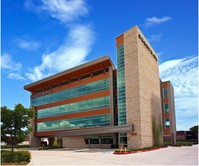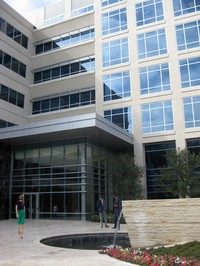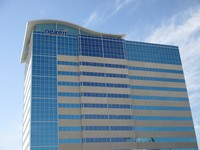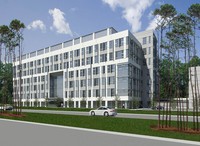Crank it Up a Notch: LEED Version 4 and the Optimism of Building

By: Andrew Carman, LEED AP BD+C, Assoc. AIA, Apollo BBC
It’s an exciting time to be in the building industry. Sometimes I imagine what it would it would have been like building in the energy crisis and late brutalist years when energy efficiency meant big, heavy envelopes, drop ceilings everywhere and no more windows. My high school was a blinking fluorescent-lit, dank nightmare of CMU. It didn’t have a bomb shelter: it was a bomb shelter. There just isn’t a color of paint you could apply to brighten up the inside of a windowless cement block cube.
Buildings like those don’t stick around because they’re nasty. People don’t keep what they don’t love, and there’s nothing quite so unsustainable as an unloved building.

Which is why it’s an exciting time to be in the building industry. Our buildings are not only increasingly built to be loved and built to last, but also to leave a lighter mark on ecological systems, and to respond better to the needs of building users—you know, people. This measured improvement gets to the crux of LEED’s (Leadership in Energy and Environmental Design’s) latest, much anticipated, and at times fairly controversial enhancements brought about in the new LEED Version 4 (v4).
If the US Green Building Council (USGBC) had done nothing else, it has certainly been pushing the building industry, in the US and around the world, to healthier, higher-performing standards. The bar set by LEED at its inception in 1998 created a challenge for builders, designers, and developers to pay closer attention to how their buildings perform in relation to energy use, water and other resource consumption, and in relation to their immediate social and natural surroundings.
And as any good limit should, LEED’s high standard became easier and easier to comply with as code and industry standards improved. We’ve come a long way, and certainly, as building professionals who chase perfection know, there’s always more to be done.

As such, last October, at it’s annual convention of building performance nerds, the USGBC announced the roll-out of LEED Version 4. It had undergone significant and prolonged public interaction, and the voting membership (comprised of building professionals from across the spectrum from designers to producers) agreed that the new mix of standards was just right. But it was a soft opening in the sense that currently a given project can still register with Version 3, or choose Version 4 until June 2015.
Under LEED v4, all of the credit categories are there, but two have been added. This caused the need to reshuffle the point schedule somewhat, though the intent is to produce a system that is at once more responsive to performance requirements as well as more demanding. Some credits have been removed from the Sustainable Sites category shifting to the new Location and Transportation category. Whereas the Sustainable Sites credit category had included, under v2009, the site itself (landscape, hydrology, heat island), as well as issues dealing with the urban environment, now the site characteristics relating to the urban environment (land use, transportation, and urban integration), comprise part of the Location and Transportation category.So what will you be getting into with the new standard? Some credits have been added, others combined or moved and a greater emphasis is being placed on building systems acting in harmony to get the best performance, longest life, and highest satisfaction from our built environments.

In a move that departs fairly dramatically from previous versions of LEED, there is now a single-point credit category. The Integrative Design Process credit (that is its own credit category) has been added to promote a more interactive and mutually supportive working environment for the various stakeholders and contractors, ultimately producing an end product building whose individual systems operate as a more efficient and synergistic whole. The Integrative Design Process can contribute to financial savings during construction and post occupancy by improving cooperative efforts amongst design and construction team members, as well as increasing building performance in relation to the natural environment by allowing designers to more thoroughly integrate their building technologies one with the others, as well as integrating them into the local natural systems.
Most of the controversy behind the new Version 4 developments sprang from the credits involving Environmental Product Declarations and Health Product Declarations, or EPDs and HPDs. These reporting mechanisms now make up part of the Materials and Resources credits under LEED v4. EPDs and HPDs are part of a new development in the building industry to be better aware of what goes into the products we use in buildings in order to better understand the impacts our buildings (made from these building components) will have on the natural world and on personal and community health.

HPDs and EPDs report on products in terms of where and how they are extracted, how they are produced and then how they will behave once installed in a building project. The intent involves increasing accountability and transparency on the part of materials producers, as well as increased awareness concerning the impacts and implications of a given product over it’s entire life cycle. This represents a general concept that is new to LEED and that is growing in the building industry. In much the same way that Integrative Design Process takes a step back to see the interaction of all the people and processes involved in the design and construction process, life cycle thinking allows for a more complete look at materials origins, effects, and destinations in the building as a whole, integrated system.
In addition to these developments, building owners and project teams can look forward to a LEED v4 with an expanded market reach. For example, LEED Building Design and Construction (BD+C) has expanded to include a rating category for Hospitality, Data Centers, as well as Warehouses and Distribution Centers; LEED Interior Design and Construction (ID+C) has added a category for Hospitality; LEED for Existing Buildings Operations and Maintenance (LEED EBOM) has expanded to accommodate existing Schools, Retail, Data Centers, and Warehouses and Distribution Centers; And LEED for Homes has adapted to better meet the needs of Multi-Family Midrise projects. So, as LEED develops according to higher industry standards, it will also include a broader range of building types.
In all, the recent enhancements to LEED under version 4 can be recognized as advancements in the building industry. We are increasingly concerned about making our buildings healthier, more efficient, and more durable—after all is that not the heart of “green building”? Green building comprises the values we share about how our buildings affect us, how they affect the world we (and the buildings) inhabit, and how well they perform in keeping us safe, healthy and happy. Our industry is optimistic. To build is to act upon the need to connect to a place, to connect people with that place. That is an optimistic outlook: it considers and plans for the future. With higher standards come better buildings. With better buildings comes a better future for all of us building users—you know, people.
Andrew Carman is a building consultant with Apollo BBC, in Houston Texas, focused on sustainable design and construction. He is experienced in architectural design, construction management, and sustainability consulting with expertise and training in whole-building performance and an approach to efficiency that comprises the process of building as a whole, open system. Andrew approaches LEED and sustainability benchmarking as a tool for providing the best possible outcomes in client projects—from maximizing day-to-day building performance to boosting leasing outcomes and market values, and a confirmation that project owners and managers are mindful of real estate values in terms of human well-being, durability, and efficiency, now and in the long term.
Subscribe Today!
Stay-in-the-know and subscribe to our blog today!